It is official, bag drag is tonight at 20:00. I am going home. I am not sure when our departure will be, but I am losing my luggage today. I will be down to my single carry on bag for however many days it takes me to get to Christchurch. Our flight time is TBD while another flight for tomorrow is already canceled. I am not optimistic about leaving as scheduled, though there could be much worse places to be delayed! I will keep the journals coming though!
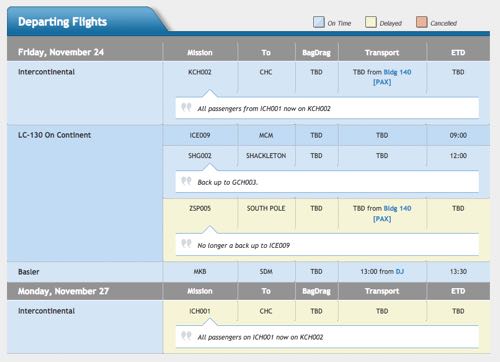 Departure schedule shows my flight is to be determined… bag drag was posted for 20:00 (8pm).
Departure schedule shows my flight is to be determined… bag drag was posted for 20:00 (8pm).
A couple of weeks ago, our team had the privilege of running our snowmobiles one last time. We left the station and headed for Cape Evans. It was a cold day, but our mission was worth the freezing temps and low visibility. We were lead to Scott Hut by Elaine Hood, an absolute angel and wealth of information. She is in charge of the Artists and Writers program, but has been a mentor to PolarTREC teachers deploying to Antarctica as well. If you ever want information about McMurdo, she is your go-to contact. She deploys each year at the beginning of the Antarctic spring and stays until all those in her program have completed their deployments. She has been doing this for years and as such, has accumulated a wealth of knowledge from logistics to science to history of the continent. Serving as our tour guide at Scott's Terra Nova Hut, she was a treasure.
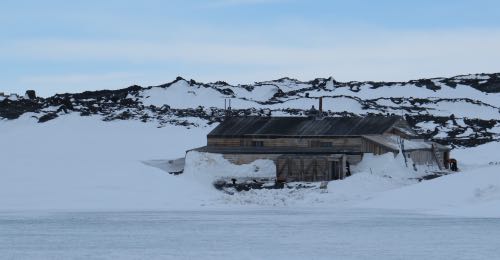 Scott's Terra Nova Hut at Cape Evans.
Scott's Terra Nova Hut at Cape Evans.
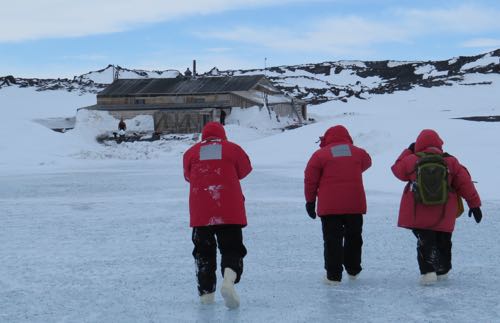 Walking on the ice to Scott's Hut was slippery and cold!
Walking on the ice to Scott's Hut was slippery and cold!
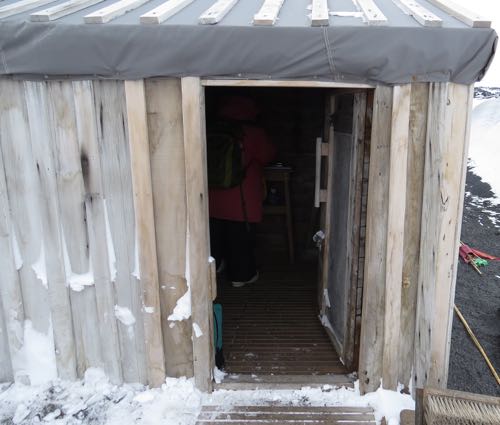 Entrance to the Terra Nova Hut was a bit short. People were shorter back in the day!
Entrance to the Terra Nova Hut was a bit short. People were shorter back in the day!
The Terra Nova Hut is full of history. Much like Discovery Hut (that I wrote about in an earlier journal), it holds artifacts, except about 1000x more of them. The hut is technically owned by the Kiwi's and so also maintained by them as well. There is a group of scientists who come each year to dig out the hut and continue restoration work. The history is one of the most captivating stories from early adventures here.
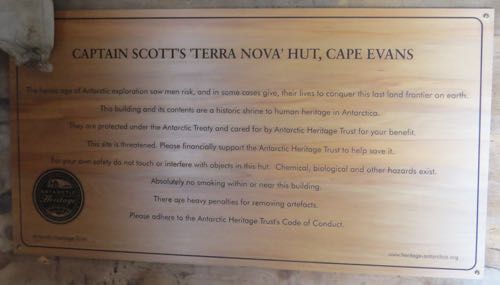 A plaque with an inscription was erected inside the hut to commemorate Scott's sacrifice to exploration of Antarctica.
A plaque with an inscription was erected inside the hut to commemorate Scott's sacrifice to exploration of Antarctica.
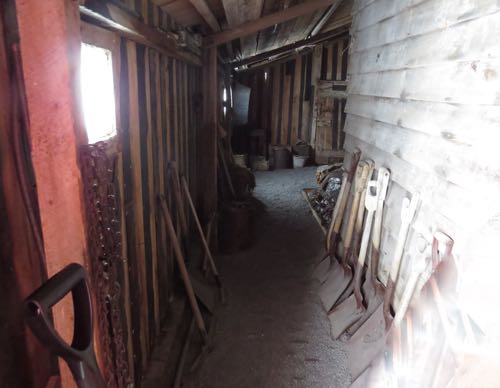 Inside the entrance is a 'porch'. The shovels are authentic. The hallway leads to the pony stalls.
Inside the entrance is a 'porch'. The shovels are authentic. The hallway leads to the pony stalls.
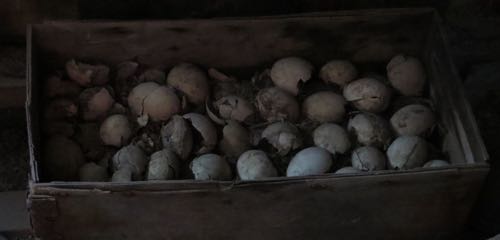 Penguin eggs were left behind in a box. Some were used for science and others probably were eaten.
Penguin eggs were left behind in a box. Some were used for science and others probably were eaten.
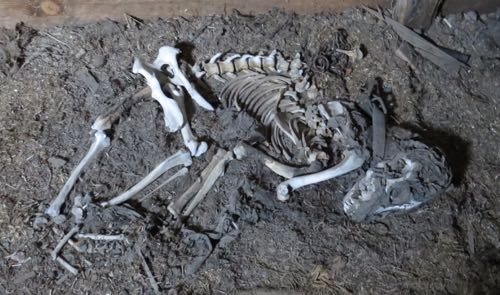 An intact skeleton of one of Scott's dogs remains.
An intact skeleton of one of Scott's dogs remains.
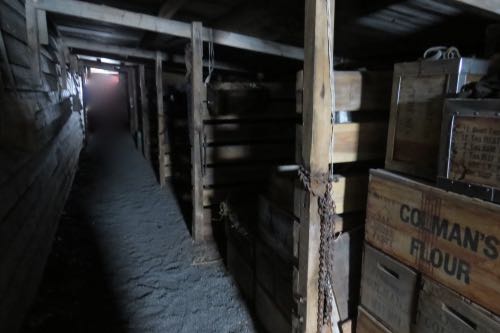 The front of the hut, enclosed several stalls for ponies and extra storage. Each stall had the name of the pony stenciled in front of it.
The front of the hut, enclosed several stalls for ponies and extra storage. Each stall had the name of the pony stenciled in front of it.
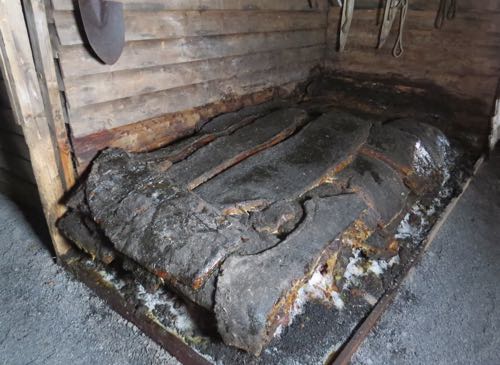 Seal fat was left behind. There is a slight odor and appears to be oozing, but it is frozen and well-preserved.
Seal fat was left behind. There is a slight odor and appears to be oozing, but it is frozen and well-preserved.
Captain Robert F. Scott was a British explorer. He intended to be the first person/party to get to the South Pole. Roald Amundsen, a Norwegian, also wanted the same, and so both men amassed parties and supplies but did not tell their crew they were headed to the South Pole, instead, claimed to be headed to the opposite pole. The Norwegian party was well outfitted, having 'studied' the Alaskan people and way of life, and had a plan that was ideal. Amundsen's expedition set off with five men, four sledges and 52 dogs, and left the Bay of Whales on Oct. 19th. Amundsen eventually slaughtered the dogs along the journey for fresh meat. Scott, while prepared, did not have the cold weather experience that Amundsen's party had. Scott brought 10 ponies, motorized sledges (that broke down quickly) and clothing that was less than ideal for the cold temps. He brought dogs, as did the Norwegian team, but only two teams of dogs that were sent back after a short time rather than used for food. He departed from the Terra Nova Hut on Nov. 1st. His initial party included 16 men in three teams but gradually, these teams would pull off and only five were in the final party and those final men had to man-haul all of their provisions.
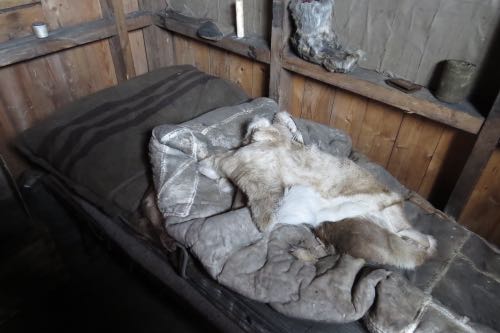 One of the beds used by Scott's men. Still has the furs and coverings from 1911.
One of the beds used by Scott's men. Still has the furs and coverings from 1911.
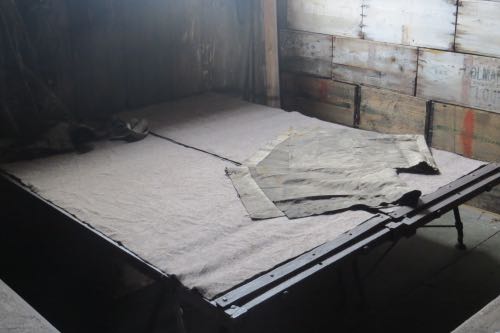 These cots were for the lowest ranking members of the Scott party and were closest to the door. Sleeping on these for two years could not have been a lot of fun!
These cots were for the lowest ranking members of the Scott party and were closest to the door. Sleeping on these for two years could not have been a lot of fun!
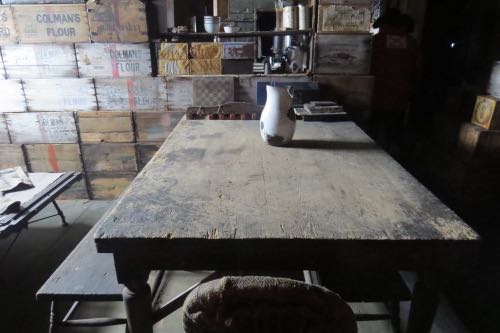 Dining table inside the hut adorned with a china vase that was beautifully painted. An odd find in a party of 16 men in Antarctica.
Dining table inside the hut adorned with a china vase that was beautifully painted. An odd find in a party of 16 men in Antarctica.
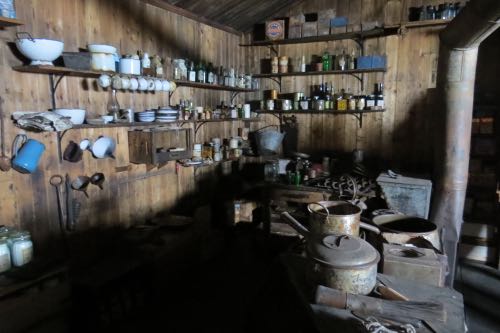 The kitchen was well stocked.
The kitchen was well stocked.
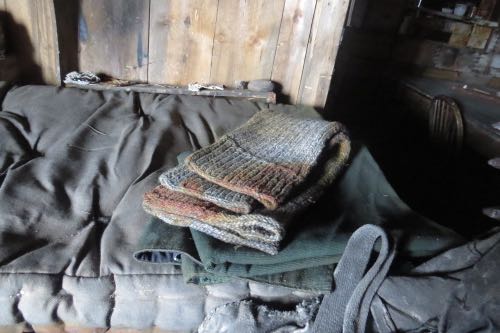 Some wool socks and pants were left behind on one of the beds.
Some wool socks and pants were left behind on one of the beds.
Scott set up the Discovery hut in 1902 on his first voyage to Antarctica, but this was now 1911. He built and established this second hut, named the Terra Nova Hut after their ship, and used this hut as the base camp. It was actually quite large as you will see in the photos below. Scott initially intended to bring himself and three other men along on the journey to the South Pole, but at the last minute, added a fifth member to their party. This was likely a fatal mistake. Scott did not have adequate food and supplies for the extra person and so, all five men willingly shared their rations and were grossly undernourished for the harsh conditions. Scott's party did make it to the pole. Amundsen's party however, had beat them to the finish line, arriving on Dec. 14th, 1911. Scott arrived one month later on Jan. 17th, 1912. Though, to Scott's credit, his party was very interested in the science of Antarctica where as Amundsen's had strictly been interested in reaching the pole for adventure sake alone. This perhaps may have been another aspect of the tragedy that was yet to befall the Scott party. Along their journey, Scott's men collected samples of rocks, that included fossils of plants, some 30lbs of rock that inevitably added additional weight they could ill afford to carry given their meager rations and lack of use of their dogs to pull their sleds. Each day the men walked a mere 10 miles but the conditions warranted this especially considering they were man-hauling their supplies.
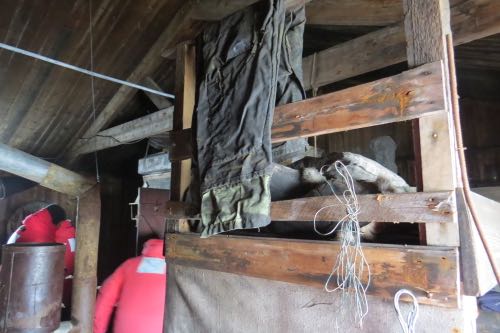 Mended pants hang over one of the beds. The men in the party had to be well versed in all things domestic, including sewing.
Mended pants hang over one of the beds. The men in the party had to be well versed in all things domestic, including sewing.
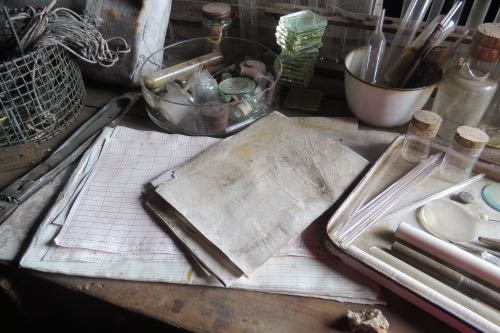 This desk served the biologist working on the team. There was also a chemist, a geologist and a photographer as part of the team.
This desk served the biologist working on the team. There was also a chemist, a geologist and a photographer as part of the team.
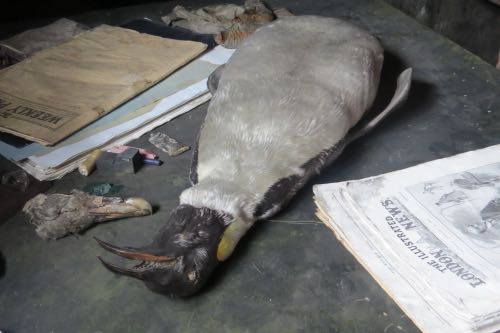 This penguin was about to be dissected when Scott's remaining part was rescued. The Emperor still lies waiting for the initial incision.
This penguin was about to be dissected when Scott's remaining part was rescued. The Emperor still lies waiting for the initial incision.
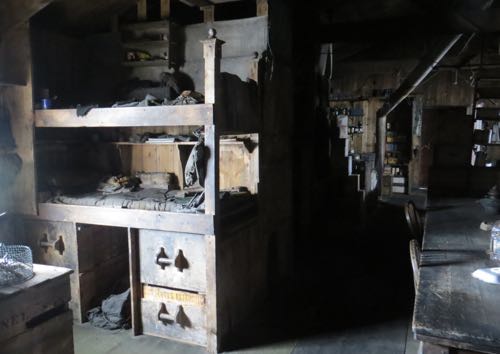 One of the bunk beds was ornate in it's design. This was a luxury I was not expecting to see in a remote hut from 1911 in Antarctica. Apparently, this belonged to the biologist!
One of the bunk beds was ornate in it's design. This was a luxury I was not expecting to see in a remote hut from 1911 in Antarctica. Apparently, this belonged to the biologist!
Scott had provided written orders to have a dog sled team meet them for their return trip, but those orders were not followed and no dog team ever came to the rescue. On their return trip home, Scott's men were the subject of several nasty storms and a temp drop below -40˚ C. This slowed their journey and forced them to again reduce their caloric intake to meager amounts. The men were starving and frozen. One of the men received a concussion and died. Another, badly frostbitten, recognizing his inability to continue walked out into the storm, never to be seen again. He sacrificed himself to try and save the remaining members of the party. The others had become frost bitten as well and likely ill from malnourishment. About 11 miles from reaching their final depot which had additional provisions and supplies and 150 miles of the Terra Nova Hut, the men encountered yet another blizzard, one that lasted for nine days, and sadly, the men perished. It was March 29th when Scott made his last entry in his journal. A search party was sent out from the Terra Nova hut when the weather and season allowed. Scott and his men were eventually discovered (1913) along with their science collections and Scott's journal that painfully reconstructed their fateful expedition. A relief ship was eventually sent to pick up the survivors in 1913.
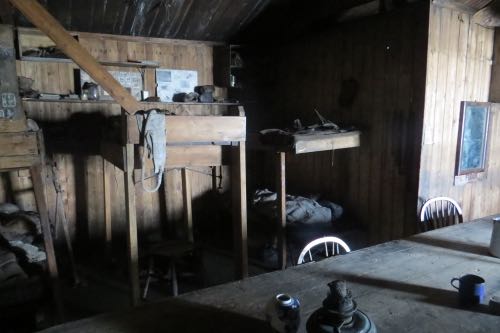 More bunks line the wall opposite the dining table. Scott slept on the bunk closest to the right.
More bunks line the wall opposite the dining table. Scott slept on the bunk closest to the right.
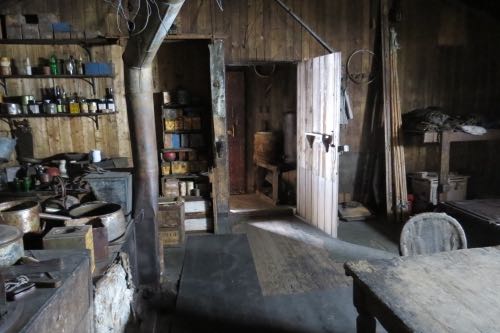 The hut was not really a hut but rather large and extravagant for such a remote location. However, with 16 men, 10 ponies and two teams of dogs, I am sure, it was pretty tight.
The hut was not really a hut but rather large and extravagant for such a remote location. However, with 16 men, 10 ponies and two teams of dogs, I am sure, it was pretty tight.
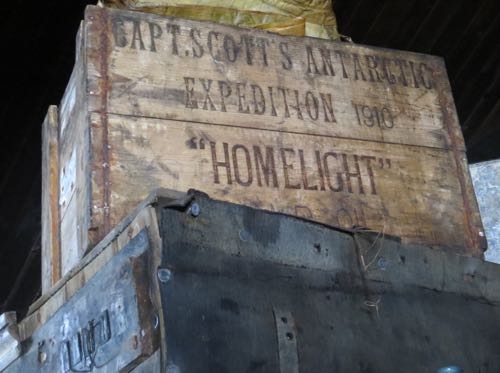 A box with Scott's expedition and name remain on the top of a cupboard.
A box with Scott's expedition and name remain on the top of a cupboard.
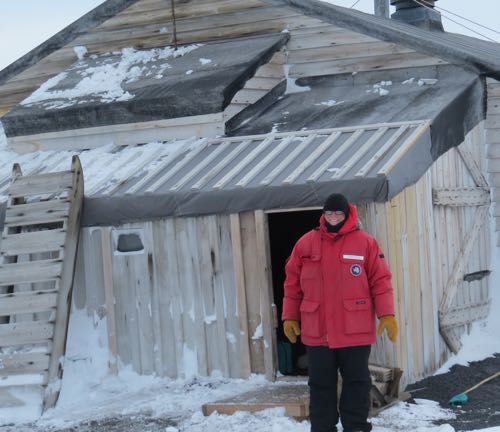 I pose for a quick photo that Hongjie snapped on an exceedingly cold day. If you look close you can see my cheeks and nose are as red as my jacket.
I pose for a quick photo that Hongjie snapped on an exceedingly cold day. If you look close you can see my cheeks and nose are as red as my jacket.
The hut has been restored to the way the Scott party left it based upon the records and photos that existed from the time. From 1915-1917, Shackleton's party used this hut as their main living quarters during his proposed trek over the continent, another story that is also a classic in Antarctica expeditions. Some of the items in the hut are original to this party, but much time has been devoted to restore the hut to the 1911-1913 Scott expedition's time there. Over the years, prior to preservation, many visitors to the hut lifted items as there was no rule/law prohibiting it and in fact, some of the sugar and other basic supplies were still being used well into the 50's when other parties would run short! As time has moved on, many of the artifacts have been returned by those who now realize the value of preserving the history. There are many books and videos that have been written and produced about Scott's traverse to the Pole. It is a fascinating story. Perhaps I have interested you in finding out more, I hope this is the case. One of the best books written on the account is below. Check it out, the price on Amazon is reasonable! Could be a great holiday gift for the history minded or curious person!
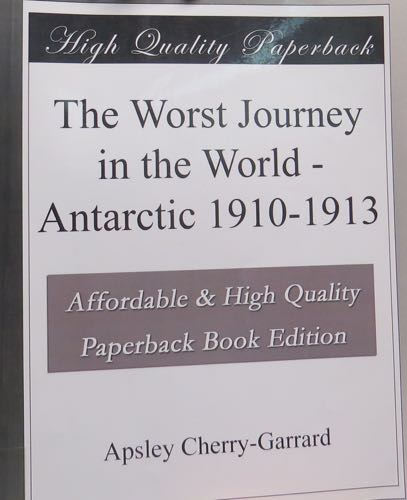 A book about Scott's journey. I have been told this is the best read ever!
A book about Scott's journey. I have been told this is the best read ever!
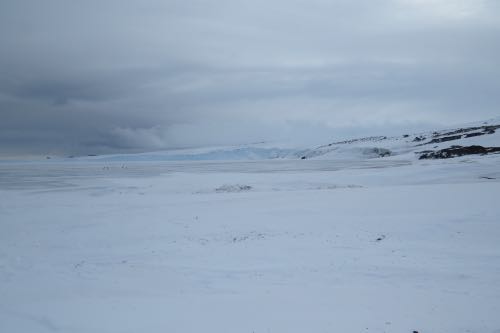 A view from outside the hut. It must have been gorgeous to look out at various times throughout the two years the Scott party occupied this hut.
A view from outside the hut. It must have been gorgeous to look out at various times throughout the two years the Scott party occupied this hut.
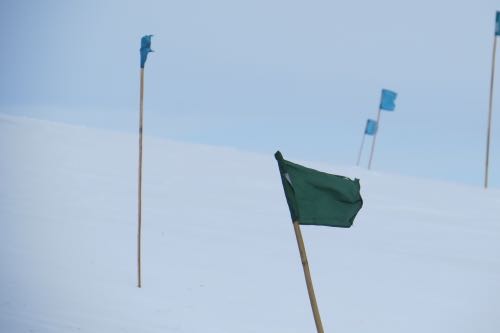 Flags show the wind we encountered this day. Bitterly cold with low visibility, but we still made it!
Flags show the wind we encountered this day. Bitterly cold with low visibility, but we still made it!
A final thanks to Elaine Hood for taking us out to see this Hut on her day off and in bad weather. She was as a remarkable tour guide and safely brought us to and back to McMurdo Station and even allowed us time to stop to see the penguins both coming and going!
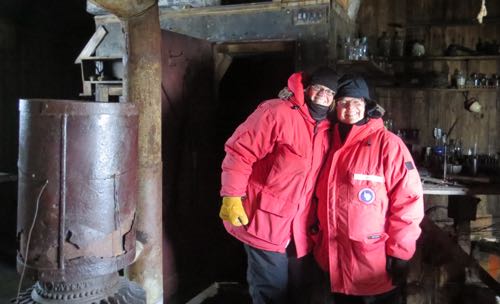 Elaine and I pose in front of the chemist's desk and dark room.
Elaine and I pose in front of the chemist's desk and dark room.
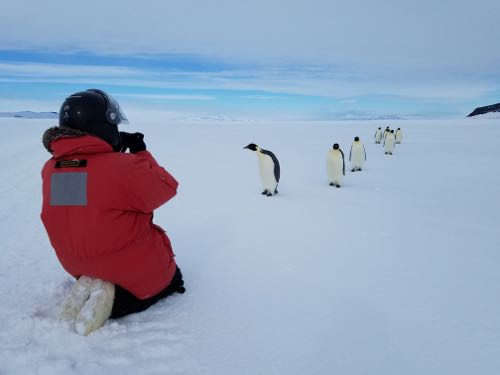 We encountered Emperor's on the journey home. This trip was such a success from start to finish! Photo by Elaine Hood.
We encountered Emperor's on the journey home. This trip was such a success from start to finish! Photo by Elaine Hood.

Add new comment